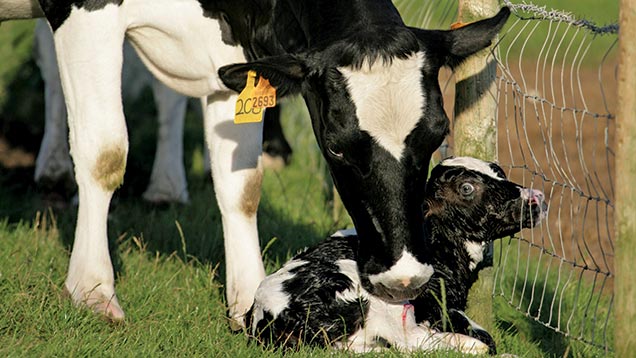Action plan to tackle disease affecting one third of dairy herds
 © FLPA/Rex
© FLPA/Rex A national plan to control a key disease present in many herds could eventually see Johne’s detection and control become mandatory for dairy farmers.
Johne‘s is an infectious wasting condition of cattle caused by paratuberculosis. The disease progressively damages the intestines of affected animals and in dairy herds; it can significantly reduce milk yields.
To tackle the disease, the industry group Action Johne’s UK unveiled a draft plan for a national Johne’s management programme (NJMP) at a conference in Worcester last week.
The aim of the voluntary, industry-led initiative is to reduce the incidence of Johne’s in dairy cattle in Great Britain through robust on-farm management practices.
One third of UK dairy herds are estimated to have a significant infection rate, according to NMR data from September 2012. Yet the uptake of control plans on many farms has been sporadic.
See also: Journey to eradicating Johne’s disease
The action group hopes to rectify this by engaging 80% of the industry.
Timetable
The programme is out for consultation until 18 January 2015, but it is hoped the first part of the voluntary programme would get under way as soon as next April.
The plan will be implemented in two phases:
Phase one (1 April 2015–30 September 2016)
- Educate farmers, vets and advisers, on the disease and its control
- Develop a coherent and consistent approach for tackling Johne’s disease on-farm
- Determine participant’s risk status and implement one control strategy on each farm to reduce infection
- Any organisations that become members of the NJMP must ensure their farmers have determined their risk status and are doing something about it
Phase two (1 October 2016 onwards)
- A review will be carried out by the NJMP steering group and the plan is to move towards a centralised approach for monitoring and control
- Appetite to grow involvement to 95% of British dairy farmers
- If achieved, the Red Tractor will be invited to consider making Johne’s detection and control a mandatory requirement for assured dairy farmers
Trading of cattle would be encouraged under certified systems that divulge the status of herds
Concerns
Concerns were raised by delegates about a contradication of priorities relating to on-going infectious disease control in parts of the UK.
In Northern Ireland there is a compulsory BVD eradication plan already under way and a voluntary Johne’s programme was launched last year (see Situation in Ireland and Northern Ireland).
Sam Strain, Johne’s programme manager for animal health and welfare NI, admitted it was difficult to know where to draw the line.
He added: “There is a case of ‘war fatigue’ setting in and that’s a concern for industry.” Despite this he said BVD and Johne’s remained top of the country’s “hit list”.
Peter Orpin, director at Myhealthyherd, said: “We’ve already got the momentum with Johne’s and I think it would be totally wrong to [drop] it.”
Chair of the Action Group on Johne’s, Lyndon Edwards, added: “International experience demonstrates that control and the reduction of Johne’s in dairy cattle is feasible and can be delivered cost effectively.
“The UK needs to ensure that its performance in tackling the disease is comparable to its main international competitors.
“We can make a real difference in tackling the disease. If we want a sustainable future for our industry we need to get a grip on Johne’s.
“A joint approach throughout the dairy industry is the right way to go and I’m confident that the National Johne’s Management Plan will deliver robust results and help us achieve a significant reduction of the disease.”
Details of the draft plan can be accessed here
Situation in Ireland and Northern Ireland
Animal Health Ireland launched a voluntary Johne’s Pilot Control Programme specifically for dairy herds in 2013.
As part of the initiative all animals over two years are screened for the disease and an approved vet carries out a risk assessment and disease management visit, with the aim of three management practices being put in place on-farm to mitigate risk.
Dr Strain says the “buy in” has been substantial. The aim was to get 1,000 herds involved and nearly double that number has enrolled at 1,752.
The programme is currently under review but Mr Strain said there’s a “strong desire” for it to continue long term.
